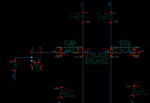Vlad Cretu
Newbie level 6
Hello,
I have rail to rail input diff pair, but I have a 100mV linear range (plotted the derivative of the currents in function of input voltage);
Could you please help with some advice on how to increase this linear range. What is more peculiar is that it's that small with tail to rail input.
Regards,
vlad
I have rail to rail input diff pair, but I have a 100mV linear range (plotted the derivative of the currents in function of input voltage);
Could you please help with some advice on how to increase this linear range. What is more peculiar is that it's that small with tail to rail input.
Regards,
vlad











